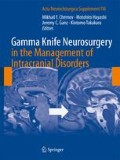Abstract
Background: Optimal management of metastatic brain disease requires precise detection and detailed characterization of all intracranial lesions.
Methods: We analyzed an experience with 3200 brain MRI investigations performed at 1.5 T and 3.0 T for identification and/or evaluation of intracranial metastases. Usually axial T1- and T2-weighted images and contrast-enhanced T1-weighted images in axial and coronal and/or sagittal projections were obtained. Fluid-attenuated inversion recovery and diffusion-weighted imaging were sometimes used as well. Routinely, 0.2 mmol/kg of gadoteridol (ProHance®) was administered intravenously, but the dose was reduced to 0.1 mmol/kg in elderly patients or in patients with mild renal dysfunction.
Findings: Magnetic resonance imaging (MRI) provided excellent information on tumor location; interrelations with functionally important intracranial structures; type of growth; vascularity; recent, old or multiple hemorrhages within or in the vicinity of the mass; presence of peritumoral edema; necrotic changes; subarachnoid dissemination; meningeal carcinomatosis. However, without administration of gado-teridol or without contrast enhancement, small metastatic tumors could not be reliably distinguished from brain lacunes. Some metastases (malignant melanoma, thyroid cancer, endocrine carcinoma, small cell lung carcinoma) may demonstrate specific neuroimaging features. Non-metastatic multiple brain lesions caused by vascular, inflammatory, demyelinative or lymphoproliferative diseases require a thorough differential diagnosis with metastatic brain tumors based not only on neuroimaging but on additional analysis of various clinical data.
Conclusion: Contemporary MRI techniques provide excellent options for detection, detailed characterization, and differential diagnosis of metastatic brain tumors, which is extremely important when choosing the optimal treatment strategy, particularly with Gamma Knife radiosurgery.
Access this chapter
Tax calculation will be finalised at checkout
Purchases are for personal use only
References
Abe K, Ono Y, Suzuki M, Akagawa H, Omoto K, Sannomiy A, Kohno M, Hayano T, Tanabe K, Teraoka S, Uchiyama S, Okada Y, Sakai S (2010) MRI findings of the post-transplant lymphoproliferative disorder of the Central Nervous System. In: Program and abstracts of the second Japanese-Russian neurosurgical symposium, 9–11 May 2010, Fujiyoshida, Japan, p 17
Camacho DL, Smith JK, Castillo M (2003) Differentiation of toxoplasmosis and lymphoma in AIDS patients by using apparent diffusion coefficients. AJNR Am J Neuroradiol 24:633–637
Chappell PM, Pelc NJ, Foo TK, Glover GH, Haros SP, Enzmann DR (1994) Comparison of lesion enhancement on spin-echo and gradient-echo images. AJNR Am J Neuroradiol 15:37–44
Fidler IJ, Yano S, Zhang RD, Fujimaki T, Bucana CD (2002) The seed and soil hypothesis: vascularization and brain metastases. Lancet Oncol 3:53–57
Hayashida Y, Hirai T, Morishita S, Kitajima M, Murakami R, Korogi Y, Makino K, Nakamura H, Ikushima I, Yamura M, Kochi M, Kuratsu JI, Yamashita Y (2006) Diffusion-weighted imaging of metastatic brain tumors: comparison with histologic type and tumor cellularity. AJNR Am J Neuroradiol 27:1419–1425
Herman DL, Courville CB (1965) Pathogenesis of meningeal carcinomatosis: report of a case secondary to carcinoma of cecum via perineural extension – with a review of 146 cases. Bull Los Angeles Neurol Soc 30:107–117
Lu H, Nagae-Poetscher LM, Golay X, Lin D, Pomper M, van Zijl PC (2005) Routine clinical brain MRI sequences for use at 3.0 Tesla. J Magn Reson Imaging 22:13–22
Kato Y, Higano S, Tamura H, Mugikura S, Umetsu A, Murata T, Takahashi S (2009) Usefulness of contrast-enhanced T1-weighted sampling perfection with application-optimized contrasts by using different flip angle evolutions in detection of small brain metastasis at 3 T MR Imaging: comparison with magnetization-prepared rapid acquisition of gradient echo imaging. AJNR Am J Neuroradiol 30:923–929
Mugler JP 3rd, Bao S, Mulkern RV, Guttmann CR, Robertson RL, Jolesz FA, Brookeman JR (2000) Optimized single-slab three-dimensional spin-echo MR imaging of the brain. Radiology 216:891–899
Nomoto Y, Miyamoto T, Yamaguchi Y (1994) Brain metastasis of small cell lung carcinoma: comparison of Gd-DTPA enhanced magnetic resonance imaging and enhanced computerized tomography. Jpn J Clin Oncol 24:258–262
Schaefer PW, Budzik RF Jr, Gonzalez RG (1996) Imaging of cerebral metastases. Neurosurg Clin N Am 7:393–423
Smith AB, Smirniotopoulos JG, Rushing EJ (2008) From the archives of the AFIP: central nervous system infections associated with human immunodeficiency virus infection – radiologic-pathologic correlation. Radiographics 28:2033–2058
Suzuki K, Yamamoto M, Hasegawa Y, Ando M, Shima K, Sako C, Ito G, Shimokata K (2004) Magnetic resonance imaging and computed tomography in the diagnoses of brain metastases of lung cancer. Lung Cancer 46:357–360
Tatsuno S, Hata Y, Tada S (1996) Double-dose Gd-DTPA: detectability of intraparenchymal brain metastasis. Nihon Igaku Hoshasen Gakkai Zasshi 56:855–859 (in Japanese)
Conflict of Interest
The authors declare that they have no conflict of interest.
Author information
Authors and Affiliations
Corresponding author
Editor information
Editors and Affiliations
Rights and permissions
Copyright information
© 2013 Springer-Verlag Wien
About this paper
Cite this paper
Ono, Y. et al. (2013). Optimal Visualization of Multiple Brain Metastases for Gamma Knife Radiosurgery. In: Chernov, M., Hayashi, M., Ganz, J., Takakura, K. (eds) Gamma Knife Neurosurgery in the Management of Intracranial Disorders. Acta Neurochirurgica Supplement, vol 116. Springer, Vienna. https://doi.org/10.1007/978-3-7091-1376-9_25
Download citation
DOI: https://doi.org/10.1007/978-3-7091-1376-9_25
Published:
Publisher Name: Springer, Vienna
Print ISBN: 978-3-7091-1375-2
Online ISBN: 978-3-7091-1376-9
eBook Packages: MedicineMedicine (R0)

